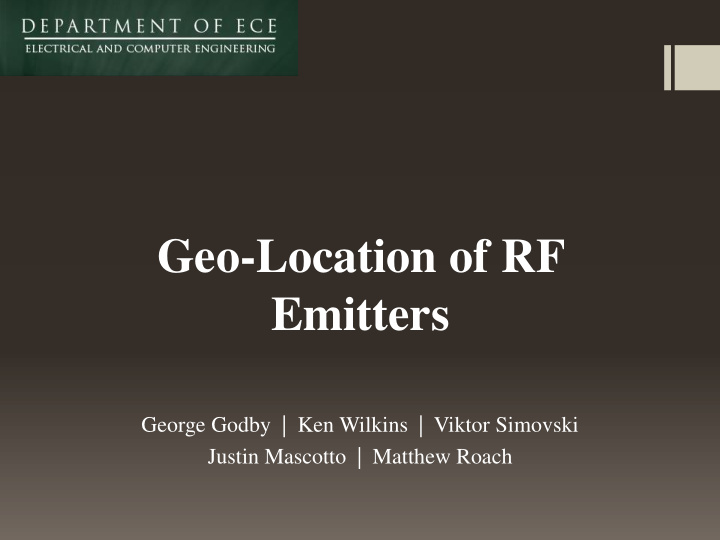



Geo-Location of RF Emitters George Godby | Ken Wilkins | Viktor Simovski Justin Mascotto | Matthew Roach
USRP: UNIVERSAL SOFTWARE RADIO PERIPERAL Manufactured by Ettus Research Relatively new technology (past ten years)
Where is the USRP in our project?
USRP: What is a Software Radio? A radio interface that contains a minimum amount of RF components Relies as much as possible on software for signal processing Works in conjunction with GNU Radio software to configure radio parameters Controlled by a PC or laptop
A CLOSER LOOK AT THE COMPONENTS (Core components highlighted in blue)
How will we use the USRP in our project? The USRP will allow us to receive any signal in to 0 to 250 MHz range. The receive frequency can be dynamically from the control PC Information about the signal is converted to a digital format for processing by GNU software Most importantly the USRP will log Radio Signal Strength (RSS) as a function of time as the antenna is swept through an area The RSS information packet will be concatenated with GPS information and sent to the GNU Software for further analysis. The Processing algorithms will help to “ paint an RF picture ” of the area, showing where a particular RF signal is peaking and thus aid in the location of RF emitter source
Antenna USRP1 is not capable of two simultaneous transmits or receives. With only one receiver, previous Antenna design no longer accommodates goal Goals: Received Signal Strength & Angle of Arrival Strategy: Gather signal levels from different angles and choose the measurement with the greatest level and thus give us an idea of the AOA (angle of arrival)
Antenna Solution: Motorized Rotating Antenna 120 Mile Reception Range 47-860 MHz Rotating Speed: 4-6 Rounds per minute 12 Seconds per 360 degree rotation Antenna Position: Antenna won’t give direction of signal Use of micro switch positioned below rotating head and combinational logic will give us position of antenna
Interfacing Hardware USRP1 Complex With so many components, a major BeagleBone task is to interface them all into a user friendly client-server WiFi module application. GPS module Laptop Hub Software USRP Hardware Driver GPS Driver GNU Radio Custom Python Application Linux OS
Software Hierarchy Linux OS Custom Python Application WiFi Ad-Hoc Network GPS Driver GNU Radio Algorithm Processing* USRP Hardware Driver Socket
GNU Radio Free & open source software Lots of documentation and avenues for support Powerful digital signal processing library Filters Sinks Sources UI Source library includes USRP Hardware Driver “block” Out-of-the-box compatibility with USRP devices. GUI Companion Provides graphical interface for creating signal processing flows. Written in Python* and can be easily included into larger application. Algorithm means Sensor-sensor communication Expandable
Possible Issues Proof of Concept One sensor, but possibility of others Antenna Position Accuracy Mobility Our design is only as good as its usability Sensor needs to be semi-compact and movable Data Movement
Questions?
Recommend
More recommend